Progress report for ONE24-466
Project Information
The
objectives of the two phases of this proposal are the
following:
Phase I:
Design, prototype, test, and
document the following products with the participating
farms:
- Automatic differential
humidistat for grain drying - Automatic small scale blueberry
sorter - Automatic greenhouse reemay
mover
Phase II:
Advertise,
prepare, and conduct 3 workshops for farmers in which attendees
learn the skills and acquire the tools to build microcontroller
projects for working farms. Participating farmers can use the
workshop to build themselves a specific device of their choosing
or use the workshop to build a sample device.
All Farms have problems that are bespoke; each farm has different crops, soil, weather, markets, size, labor conditions, and financial situations. Small farms have the added problem that custom solutions take longer to be profitable. Arduino (and its variations) is a problem solving system designed specifically for prototyping and solving unique problems for use by amateur designers and developers. Arduino’s educational spirit (open source everything) and modular, mass produced parts make it easy and affordable to use.
Farms already use arduino for many applications in control (irrigation, heating, cooling, ventilation), automation (motors, processing crops, cleaning/washing), monitoring/communication (data collection, marketing, sales).
Phase I of this grant proposes completing 3 microcontroller projects. The three projects are all projects for which no solution currently exists on line or as a product. More importantly, they are projects which farms have requested and for which there are applications on more New England farms. And finally, they are projects which are more complex and larger than a simple sensor or smart switch and therefore require research and iteration.
Project 1: Differential humidistat for drying grain in plenum bin. Uses logic and automation to control electricity to a blower for maximizing grain drying rate and minimizing energy use. Uses inlet and outlet airstream humidity and temperature as inputs , and a relay to the blower(s) as output. Anni Schmidt and I prototyped and installed this device in 2023 (with help from intern Meagan Rittmanic, Olin College). The remaining work is to test the prototype in the lab, collect data, and validate the results.
Project 2: Blueberry sorting. Sorts blueberries into marketable, over ripe, and under ripe. Uses color and shape recognition sensors as input, and a servo gate as output. We will attempt to integrate open source machine learning code with a microcontroller and a servo gate and use sorted blueberries as a training data set.
Project 3: Reemay moving. Automatically covers greenhouse crops with reemay on cold nights, and uncovers them on warm mornings. Uses temperature and light as input, and a motor control as output. The computer code for this project is simple, while the mechanism and construction will be extensive.
Phase II of the project (arduino workshops for farmers) seeks to provide a service for farmers which they have requested; hands-on workshops where farmers can familiarize themselves with microcontrollers and acquire the tools and skills to do their own projects.
Teaching microcontroller use to farmers has three benefits:
- Allows farmers to complete their own projects
- Allows farmers to understand and use microcontroller recipes from the internet
- Allows farmers to grasp and communicate the possibilities and limitations of microcontrollers when seeking help or products from other people.
In the world of microcontrollers there is a basic level of knowledge, vocabulary, and tools that allow a designer to use the open source online resources to accomplish a lot without ever needing expertise in either electronics or programming. This is because the difficult circuits and code are already available and can be either purchased inexpensively or downloaded for free. Best of all, there is a “modular” aspect to both the sensors, the circuits, and the code that allows building blocks (think of legos) to be assembled in a variety of ways to accomplish different tasks. This modularity on three levels (hardware, or "atoms"; electrical wiring, or "wires"; and computer code, or "bits"), allows different projects to be similes of each other.
Cooperators
Research
1/7/25 Research/Construction Update:
To date I have conducted research and construction in the Phase 1 areas of this grant: 1. automatic dehumidistat, 2. blueberry sorter, and 3. greenhouse reemay mover. Below I summarize this progress:
- Automatic dehumidistat. In August I met with the participating farmer, Chuck Currie, Freedom Food Farm, and collected information on his current grain drying system and what improvements he proposes. In September and October I built a test system to compare humidity sensors and collected data on temperature/humidity sensors that will be useful in March when I start construction of the bench-scale prototype. I was able to use my clothes dryer as a proxy source of a humid airstream and this worked well, allowing me to passively collect data while doing the chores. I am focusing on using the DHT-22 temperature/humidity sensor, as it is inexpensive and accurate enough. Through analyzing the data from my clothes dryer, I think I now understand a technical property of the DHT-22 that was confounding my previous attempts to code the control logic on the differential humidistat; namely, that the temperature and relative humidity readings are out of phase by a matter of seconds, which makes using the data for determining absolute humidity a difficulty. If true, this hypothesis would explain problems Anni Schmidt (who wrote the original code) described in our previous attempts at using these sensors on a grain dryer. One remaining strategic question is whether or not it is possible to monitor the grain dryness directly, or whether, as I have assumed in the past, it is necessary to use moisture in the airstream as an indicator of drying activity. This will be the first question I address in the Spring.
- Blueberry sorter. In August I met with Dr. Mbanisi of Olin College of Engineering. We agreed to prototype the blueberry sorter with a team of students from his Robotics and Mechatronics class at Olin. In August we collected data on sorted blueberries (blueberries sorted by the farmer by hand) by taking digital photos of blueberries with a special shape and color recognition camera. This data became the basis for training a computer to discern between the 3 proposed categories of blueberry: Ripe, underripe, and overripe. The student team convened in September: Jacob, mechanical/electrical, Alana, electrical, and Luke and AJ, code. Through the Fall I worked closely with Dr. Mbanisi and the team to develop a working prototype which will be used in field trials July 2025. The blueberry sorter mechanically processes blueberries from a hopper to a single file of blueberries on a conveyor belt. The blueberries pass under a camera that sends images to a microcomputer. The microcomputer classifies the individual blueberries and then activates pneumatic valves that use bursts of air to separate the blueberries into 3 bins. By the end of their semester, AJ, Alana, Jacob, and Luke had a benchtop prototype that worked in the lab (though in December it's difficult to obtain unsorted local blueberries to test the device). The prototype sorts about a blueberry per second, has a materials cost of about $500, and an accuracy rate between 85-93% . One other interesting feature is that it is really a "delicate object sorter", quickly adaptable to sorting any berry or seed. There are still, however, mechanical and code issues that the students wish to address in the coming semester. Field trials for the Sorter will begin in July 2025, and by then I hope to have two working prototypes so we can get the most data possible from the limited time during which we'll have fresh blueberries. Adam and Carissa (the participating farmers) are ideal collaborators; they are available and supportive when consulted, and go out of their way to make the farm and blueberry sorting shack available to the engineers on the project. I am cautiously optimistic that within the $500 for parts budget, a small-scale blueberry sorter can be made.IMG_6904 2.
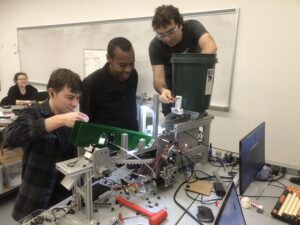
Blueberry Sorter under development 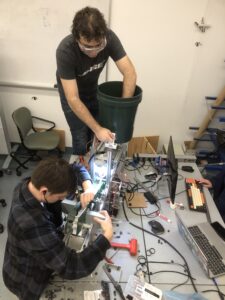
Jacob and AJ working on the Blueberry Sorter 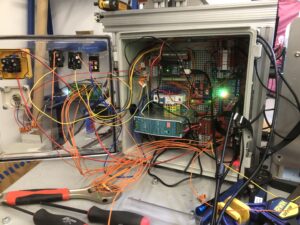
Close-up of Blueberry Sorter electronics at Olin College of Engineering - Reemay Mover. In August and September I prototyped a bench scale model of the Reemay Mover and wrote the software sketch and tested it. By October I had a 1/4 scale model working in my front yard. The design is based on a motorized roller for greenhouse side flap ventilation, a proven product already familiar to many winter production greenhouse farmers. To date I've made three attempts to construct the Reemay Mover at full scale (50' x 30') in one of Roots Farm's winter production greenhouses. The control, logic, and electrical (bits and wires) part of the machine works well. The design principle of "fail-to-manual" works well in this machine; a farmer can quickly disconnect the motor and roll the reemay by hand. So even without the "robotic" part of the device, it is still saving labor. The mechanical part (the atoms) is proving difficult. Problems of steering error correction, proper tensioning of the reemay, and tucking in the sides of the reemay have all been tricky. I have poured work in to this part of the project and made some progress without drastically changing the design path or increasing the cost of materials in the machine. However, it is also prudent to consider other design paths that use the same logic and controls but a different mechanical scheme. The unforeseen mechanical problems with this project have quickly eaten up the planned labor budget. However, because I feel like the problems can be solved, and I feel this design could have a large positive impact in New England, I'm committed to making it work. I believe I can borrow labor hours from the other phase 1 projects and stay within the overall phase 1 budget. Kelli and Mike (Roots Farm) are enthusiastic collaborators; their farm is already compact, carefully planned, and technologically advanced, making it a good fit for testing a technology like the Reemay Mover.
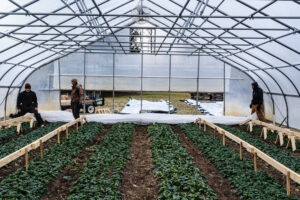
Full-scale Reemay Mover
Photography by James Davis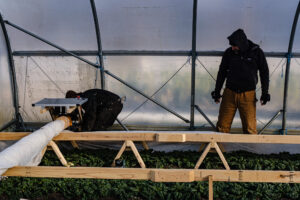
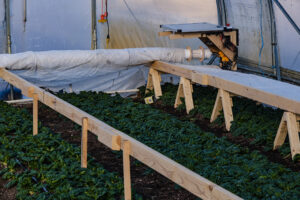
Education & Outreach Activities and Participation Summary
Participation Summary:
The Phase II workshops are the primary form of outreach– they will share the results of the Phase I projects as they equip the attendees to use microcontrollers on their own farms.
Additionally, the project designs will be documented and uploaded to Farmhack. The goal of the documentation is that it would allow a farmer with an introduction to microcontrollers (such as an attendee of one of the workshops) to complete the project.